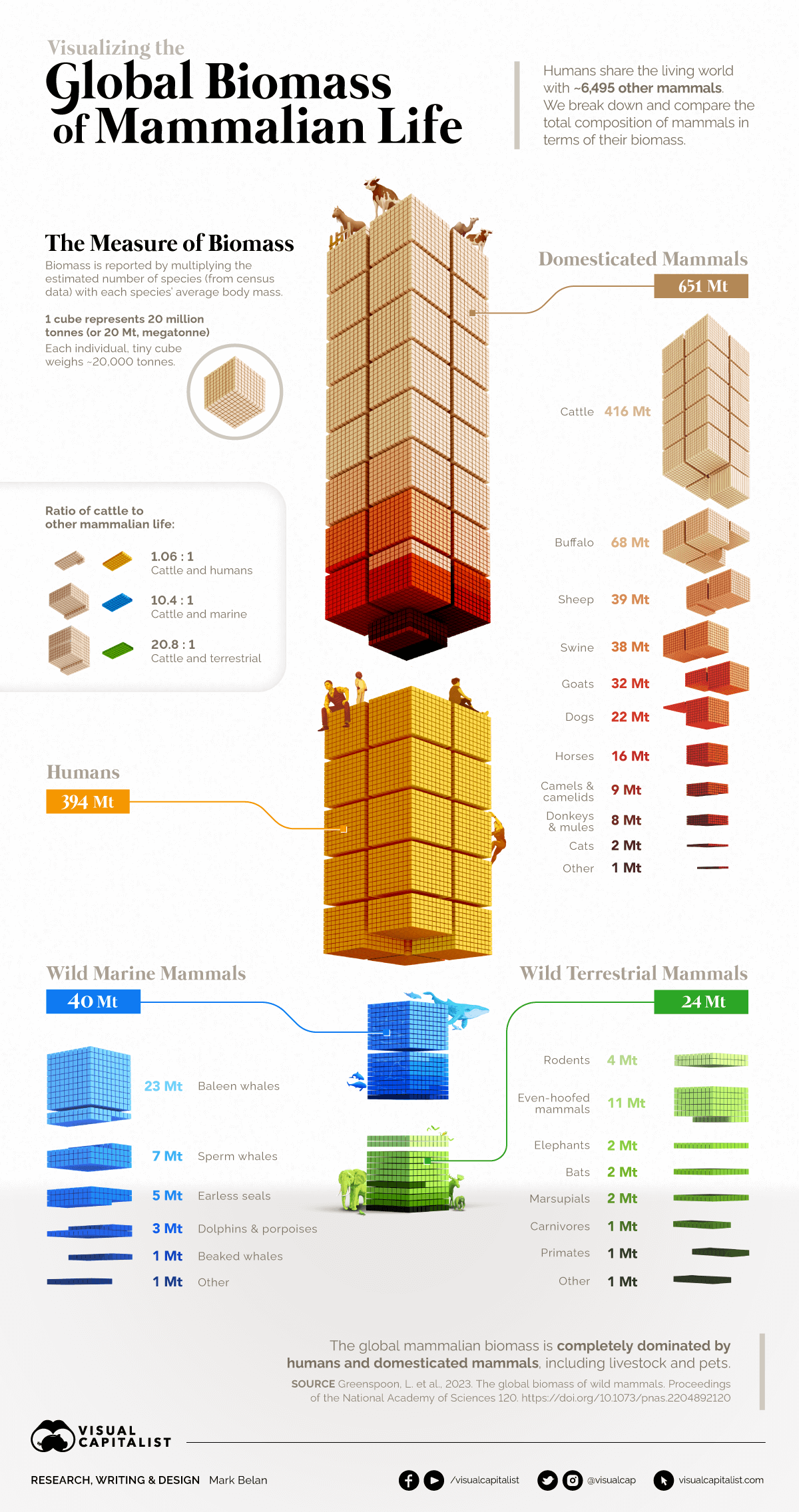
Visualizing the Biomass of All the World’s Mammals
Even as we understand more about the world we live in, certain aspects of it remain undefined or hard to comprehend.
One such example is in the scale and distribution of Earth’s life. What’s the ratio of wild to domesticated animals? How much do all of the world’s humans weigh?
Until recently, such questions were nearly unanswerable. A new report titled The Global Biomass of Wild Mammals helps shed more light on the composition and scale of life on our planet. The research provides an estimate of the biomass of all mammals, globally—including humans.
So, What is Biomass Anyway?
Biomass is simply the weight of living things.
In this study, researchers
created rough estimates for four major categories of mammals: humans, domesticated animals, and those that were found in wild terrestrial and marine environments. A further breakdown of mammal groups are found within each category.
To achieve this, they took the estimated number of species from census data and multiplied it with each species’ average body mass.
One component worth pointing out is that animals contribute very different amounts to the world’s biomass total. For example, whales significantly outweigh rodents in terms of biomass, even though there are fewer species and populations of whales. The fact that whales are so much larger than rodents means that even smaller populations can contribute a meaningful portion to overall biomass.
Mammalian Biomass, Organized Neatly
Each larger cube above represents 20 million metric tons of carbon, and the entirety of the visualization represents all living mammalian life on Earth.
The paper separates mammals into four distinct categories:
| Category | Total Mass (Mt) | Top Sub-Category |
|---|---|---|
| Domesticated Mammals | 651 | Cattle (416 Mt) |
| Humans | 394 | n/a |
| Wild Marine Mammals | 40 | Baleen Whales (23 Mt) |
| Wild Terrestrial Mammals | 24 | Even-Hoofed Mammals (11 Mt) |
| Total | 1,109 |
One of the most obvious takeaways from this data is that humans make up one-third of total mammalian biomass.
Perhaps even more strikingly, the animals we’ve domesticated for food, companionship, and labor make up close to 60% of the total weight of Earth’s mammals. Domesticated dogs and cats alone equal the total weight of all other wild land mammals combined.
The world’s sheep, on their own, weigh as much as all the whales and seals in the ocean. Domesticated buffalo such as the water buffalo, a species commonly found in Asia, combine to have the third largest biomass of all mammals.
Finally, there’s one category of mammal that comes way out on top.
Cattle Planet
The global livestock population has risen along with the human population, and cattle are now the top mammal in the world by weight.
In fact, just the United States’ share of cattle matches the biomass of all wild mammals on Earth.
As the standard of living continues to rise for people around the world, beef consumption has been increasing in many developing countries. Of course, raising cattle is a resource and land intensive operation, and there have been very real impacts on a global scale. For one, cows are a major source of methane emissions. As well, in Brazil, which accounts for around 25% of the world’s cattle population, pasture has directly replaced large swaths of rainforest habitat.
Waning Wildlife
At the very bottom of the visualization, dwarfed by humans and domesticated mammals, lies the vast array of wild mammals that live on planet Earth.
It’s sobering to see that the biomass of North America’s human population alone compares closely with that of all terrestrial wild mammals in the world. This includes plentiful creatures like rats and mice, as well as large mammals like elephants and bears.
Below are the top 10 wild mammalian contributors to biomass in the natural world.
| Rank | Contributor | Total Mass (Mt) | Individuals (millions) |
|---|---|---|---|
| #1 | Fin Whales | 8 | 0.1 |
| #2 | Sperm Whales | 7 | 0.4 |
| #3 | Humpback Whales | 4 | 0.1 |
| #4T | Antarctic Minke Whales | 3 | 0.5 |
| #4T | Blue Whales | 3 | 0.05 |
| #6 | White-Tailed Deer | 2.7 | 45 |
| #7 | Crabeater Seals | 2.0 | 10 |
| #8 | Wild Boar | 1.9 | 30 |
| #9T | African Elephants | 1.3 | 0.5 |
| #9T | Bryde's Whales | 1.3 | 0.1 |
In the ocean, whales and seals are the heavyweight champions. On land, deer, and boar come out on top as they are both heavy and plentiful.
Humans have a complicated relationship with large mammals. We feel a very clear connection to these creatures, and they are often the key figures in conservation efforts. That said, even small populations of humans have wiped out large mammal species in the past.
The news that cattle outweigh wild land animals by a factor of 20:1 is a reminder that human influence is perhaps even more powerful than we think.
















